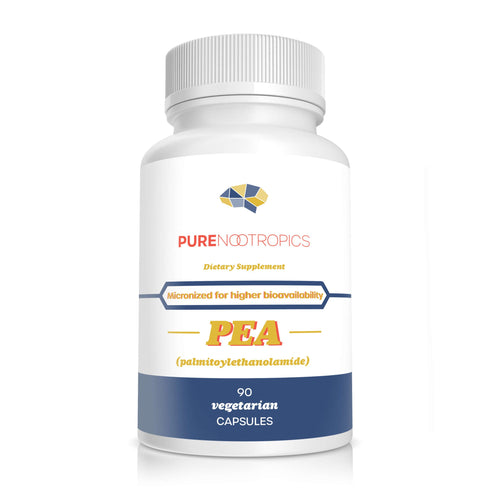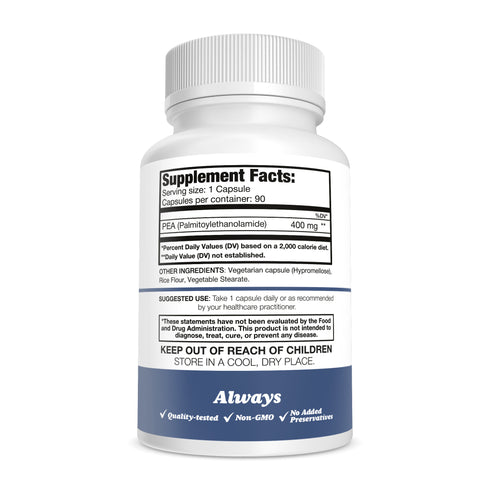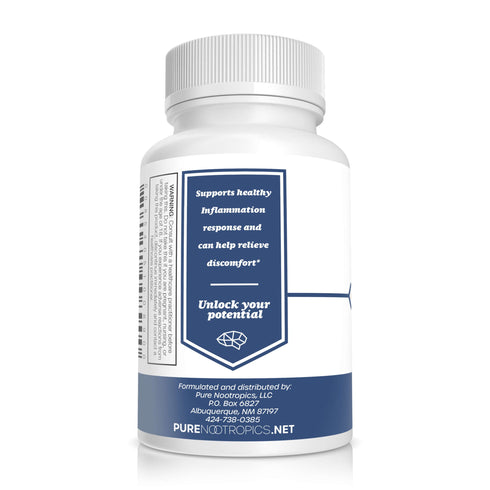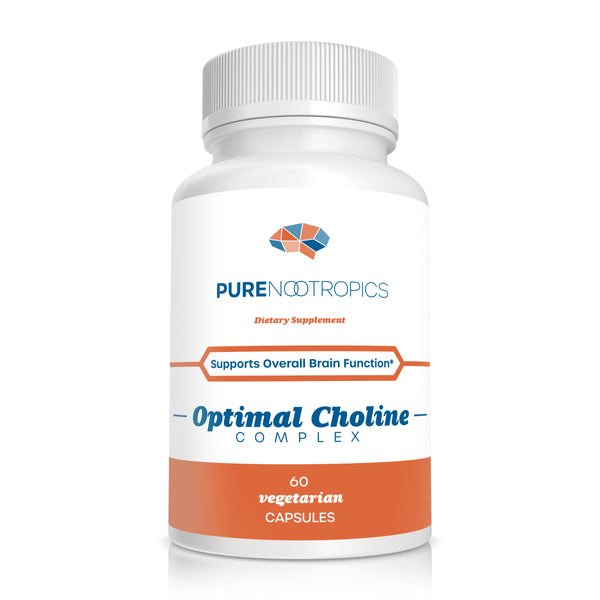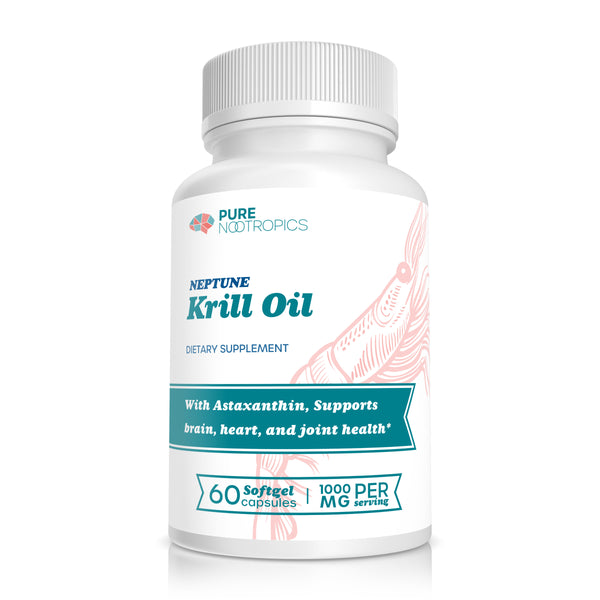Micronized Palmitoylethanolamide (PEA) is a molecule which has been formulated for better oral bioavailability and absorption. It modulates inflammatory responses and responses of the immune system as a fatty acid amide.
PEA is produced endogenously within the human body, but it can also be found in the tissues of plants and animals. It was originally isolated in egg yolks and now is commonly isolated from soy lecithin (1)(2).
The micronized form of PEA provides superior absorption in two ways. Micronized PEA has a smaller particle size, which allows it to diffuse more efficiently on a cellular level. The smaller, micronized size also allows the particle to contain more energy for cellular distribution. The micronized formulation ensures a more effective delivery system than non-micronized PEA (3).
Palmitoylethanolamide Benefits
- Supports relief from occasional discomfort (ref)*
Palmitoylethanolamide Mode of Action
PEA consists of palmitic acid and ethanolamine. It is the hydrolyzed form of N-(2-hydroxyethyl)-palmitamide, a crystalline structure isolated in soy lecithin. It is this hydrolyzed substance that accounts for its ability to promote a healthy response to inflammatory stressors which was first noted by scientists in 1957. PEA’s effects on the immune system have been studied since 1939 (1).
PEA can be synthesized within the human body from the abundant fatty acid palmitic acid, but it is not dependent or influenced by dietary consumption of fatty acids. Palmitic acid in the diet is derived from dairy products such as cheese and butter, palm tree oil, and animal meat products. However, increasing palmitic acid in the hope of increasing endogenous PEA synthesis will not be effective (1).
PEA restricts pro-inflammatory molecules, such as cytokines and interleukins.
PEA has been studied for its immunological effects since its discovery in 1939 and remains one of the most researched and published compounds (more than 300 scientific papers have been written about it in just the past 50 years). The end of the twentieth century fostered the biggest expansion of research into PEA’s role in the endocannabinoid system (1).
PEA indirectly acts on the ECS (endocannabinoid system) within the human body. Consisting of lipid-based neurotransmitters and proteins designed to pair up with cannabinoid receptors in the peripheral nervous system and brain, the ECS is still being thoroughly studied. The ECS is believed to influence areas of development, memory, fertility, the sensation of discomfort, and the immune system. PEA activates receptors similar to the cannabinoid receptor CB2 but does not display any actual connection to the receptors CB1 or CB2. Instead, it functions through an entourage effect which results in the activation of the ECS (6)(7)(8)(9).
Palmitoylethanolamide Dosage
Pure Nootropics’ Micronized PEA capsules provide 400 mg per 1 capsule. Suggested use for adults is 1 capsule by mouth once daily, or as directed by your healthcare practitioner.
† For further information, please see references tab above.
The references below are not meant to imply that any of our products treat, cure, or diagnose any disease or human condition. References to clinical studies and pre-clinical studies may use varying dosages and may not represent the dosages or subsequent results of products we sell; however, the references provided are pertinent to the subject supplement itself. References provided are intended for research and informational purposes only and do not represent the entire body of knowledge available on the subject(s) referenced; nor do they represent all possible outcomes associated with the subject(s) referenced including, but not limited to, adverse effects, precautions, or chemical interactions within the human body. The Content provided on this website is not intended to be a replacement for professional medical advice, treatment or diagnosis. Never ignore the advice of a medical professional or delay in attaining professional advice because of information or impressions you gather on this website. Choosing to rely on any information provided by the Content of this website is solely at your own risk. We encourage our audience to do their own research beyond the resources we have provided so your decision is as educated as possible.
• Supports relief from occasional discomfort*
Artukoglu BB, Beyer C, Zuloff-Shani A, Brener E, Bloch MH. Efficacy of Palmitoylethanolamide for Pain: A Meta-Analysis. Pain Physician. 2017 Jul;20(5):353-362. PMID: 28727699. https://pubmed.ncbi.nlm.nih.gov/28727699/
4. “Interleukin.” Encylopaedia Brittanica, https://www.britannica.com/science/interleukin.
5. “Cytokine.” Encylopaedia Brittanica, https://www.britannica.com/science/cytokine
6. Guida, F et al. “Palmitoylethanolamide induces microglia changes associated with increased migration and phagocytic activity: involvement of the CB2 receptor.” Scientific reports vol. 7,1 375. 23 Mar. 2017, doi:10.1038/s41598-017-00342-1. https://www.ncbi.nlm.nih.gov/pmc/articles/PMC5428303/
7. “Endocannabinoid System.” Wikipedia, https://en.wikipedia.org/wiki/Endocannabinoid_system.
11. Nestmann, Earle R. “Safety of micronized palmitoylethanolamide (microPEA): lack of toxicity and genotoxic potential.” Food science & nutrition vol. 5,2 292-309. 15 Jun. 2016, doi:10.1002/fsn3.392. https://www.ncbi.nlm.nih.gov/pmc/articles/PMC5332261/


